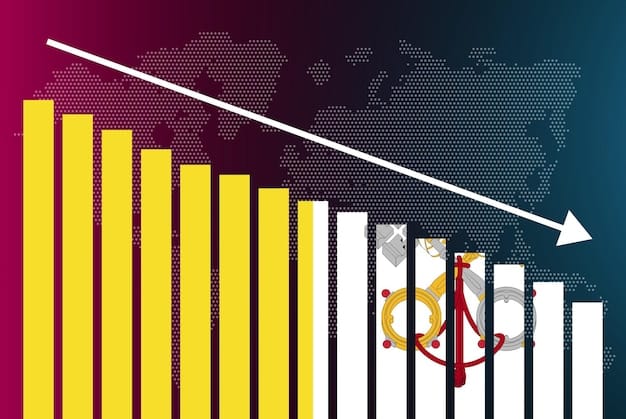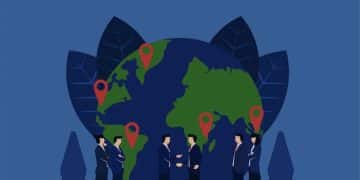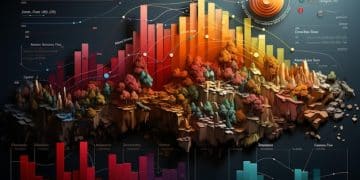US Immigration Policy Changes: Potential Consequences Examined

Proposed changes to US immigration policy carry multifaceted implications, potentially reshaping economic landscapes, social integration, and international diplomatic relations, demanding careful consideration of their far-reaching effects on various sectors.
In a dynamic global landscape, the realm of immigration policy stands as a critical pillar, constantly subject to review and revision. This article delves into the intricate subject of Examining the Potential Consequences of the Proposed Changes to the US Immigration Policy, a topic that resonates deeply across economic, social, and geopolitical spheres.
Understanding the Landscape of US Immigration Policy
The structure of US immigration policy is a complex, multi-layered system designed to regulate who can enter the country, for how long, and under what conditions. Historically, this framework has evolved in response to shifting economic needs, humanitarian concerns, and national security imperatives. Understanding its current contours is essential before examining any proposed alterations.
Current US immigration policy encompasses various categories, including family-sponsored visas, employment-based visas, refugee and asylum programs, and the Diversity Visa Lottery. Each category serves distinct purposes and is governed by specific regulations. The interplay of these components creates a delicate balance, influencing demographic shifts, labor markets, and social dynamics across the nation. Any significant change within one of these areas can ripple through the entire system.
Historical Evolution and Precedents
US immigration policy has rarely been static. From the Immigration Act of 1965, which reformed national origin quotas, to more recent legislative debates surrounding border security and pathways to citizenship, policies have consistently adapted. These historical precedents offer valuable insights into the potential impacts of future changes.
- 1965 Immigration and Nationality Act: Repealed the discriminatory national origins quota system, prioritizing family reunification and skilled labor.
- Immigration Reform and Control Act of 1986 (IRCA): Granted amnesty to millions of undocumented immigrants while imposing employer sanctions.
- Post-9/11 Measures: Increased focus on national security, leading to stricter vetting processes and border enforcement.
- Deferred Action for Childhood Arrivals (DACA): An executive action protecting certain undocumented immigrants brought to the US as children from deportation.
Examining these shifts allows for a more nuanced understanding of how previous policy adjustments have shaped American society and what lessons can be drawn for future reforms. The debate often centers on balancing economic growth, national identity, and humanitarian responsibilities.
The current policy framework is a product of decades of legislative action and judicial interpretation, reflecting diverse priorities and political negotiations. Proposed changes, therefore, are not introduced into a vacuum but interact with an already established and intricate system. This foundation sets the stage for a thorough analysis of the potential consequences.
Economic Ramifications of Policy Shifts
Changes to US immigration policy inevitably carry substantial economic consequences, affecting labor markets, consumer demand, innovation, and government revenues. The magnitude and direction of these impacts depend heavily on the nature of the proposed alterations, whether they tighten restrictions, ease pathways, or prioritize specific skill sets.
A reduction in legal immigration, for instance, could lead to labor shortages in critical sectors, particularly those reliant on immigrant workers such as agriculture, construction, and certain service industries. While some argue this could boost wages for native-born workers, others contend it might lead to increased automation, outsourcing, or a decline in overall economic output. Conversely, expanding immigration pathways could alleviate labor market pressures and stimulate growth, though concerns about wage suppression in specific sectors might also arise.
Impact on Labor Markets and Wages
Immigrants often fill jobs that native-born workers are less willing to do, or they possess specialized skills that are in high demand. Policy changes that restrict these flows could disrupt supply chains and reduce productivity. For example, highly skilled immigrants are frequently founders of new businesses and contribute significantly to innovation, particularly in the tech sector.
- Agriculture: A significant portion of agricultural labor is performed by immigrants, making the sector highly vulnerable to labor shortages if policies become more restrictive.
- Healthcare: Many doctors, nurses, and caregivers are foreign-born, crucial for addressing an aging population’s healthcare needs.
- STEM Fields: Immigrants are disproportionately represented in science, technology, engineering, and mathematics, driving innovation and competitiveness.
The effect on wages is a contentious point. Economic studies offer mixed results, with some suggesting a minimal impact on overall native-born wages, while others point to potential downward pressure in specific low-skill sectors. The broader consensus often highlights that immigrants either complement the native-born workforce or fill niches, rather than directly competing for the same jobs.

Effects on Government Revenue and Public Services
Immigrants contribute to government revenues through taxes—federal, state, and local—including income tax, sales tax, and property tax. Policy changes that significantly alter immigration flows will directly impact these revenue streams. Fewer immigrants could mean a smaller tax base, potentially straining public services.
At the same time, immigrants utilize public services like education, healthcare, and infrastructure. The net fiscal impact—whether immigrants contribute more in taxes than they consume in services—is often debated and can vary depending on their legal status, age, and skill level. Comprehensive immigration reform that integrates more individuals into the formal economy typically leads to a more positive fiscal outcome.
Ultimately, the economic ramifications of proposed immigration policy changes are complex and deeply intertwined with the broader economic health of the nation. Thoughtful consideration of these impacts is crucial for crafting policies that support sustainable growth and prosperity.
Social and Cultural Integration Dynamics
Immigration policy changes extend beyond the purely economic, profoundly influencing the social and cultural fabric of the United States. These shifts can alter community demographics, impact social cohesion, and shape the ongoing dialogue about national identity. The effectiveness of integration policies plays a crucial role in these outcomes.
When policies foster inclusive pathways for integration, new arrivals can contribute to the vibrancy of American society, introducing new traditions, cuisines, artistic expressions, and languages. Conversely, policies that create barriers or foster exclusion can lead to social fragmentation, increased vulnerability for immigrant communities, and potential social unrest. The debate often centers on how best to balance cultural preservation with common national values.
Community Cohesion and Demographics
Immigration has historically been a driving force behind demographic shifts in the US, contributing to its diverse population. Changes in immigration policy can accelerate or slow these trends, impacting the age structure of the population, ethnic distribution, and regional concentrations. For example, a policy that prioritizes skilled workers might attract different demographics than one favoring family reunification.
- Urban Growth: Immigrants often contribute to the revitalization of urban areas, opening businesses and contributing to local economies.
- Rural Decline: In some rural areas, immigration has helped stem population decline and fill labor gaps in industries like agriculture and meatpacking.
- Cultural Enrichment: Immigrant communities introduce new perspectives, food, music, and traditions, enriching the broader cultural landscape.
The integration process is not one-sided. It requires efforts from both immigrant communities to adapt to new environments and from host societies to be welcoming and provide resources for successful assimilation. Policies that support language acquisition, educational opportunities, and pathways to civic engagement are vital for fostering community cohesion.
Impact on Education and Healthcare Systems
Educational institutions and healthcare systems also bear the direct impact of immigration policy changes. Schools often serve as primary points of integration for immigrant children, offering language support and cultural orientation. Increased immigration can place demands on school resources, while a decline might alter enrollment dynamics.
Similarly, healthcare systems are affected by changes in immigrant populations. Immigrants access healthcare services, and their health outcomes are influenced by their legal status, access to insurance, and understanding of the system. Policies that restrict access to care for certain groups can have broader public health implications, while those that expand access can improve overall community health.
Ultimately, the social and cultural consequences of immigration policy shifts emphasize the need for thoughtful policy design that considers not just economic efficiencies but also the well-being and integration of all residents, fostering a more cohesive and diverse society.
Implications for National Security and Border Control
The realm of national security and border control is frequently at the forefront of discussions surrounding US immigration policy. Proposed changes often aim to enhance security measures, streamline border processes, or address perceived vulnerabilities. However, these changes carry complex implications, sometimes creating unintended consequences.
Stricter border enforcement, for instance, might be intended to deter illegal crossings but could also push desperate individuals into more dangerous routes, leading to humanitarian crises at the border. Conversely, proposals to ease certain restrictions might be viewed as a national security risk by some, while proponents argue they allow for better vetting and tracking of individuals.
Border Enforcement and Management Strategies
Any comprehensive overhaul of immigration policy typically involves a re-evaluation of border enforcement strategies. This can include increased deployment of personnel, advanced surveillance technologies, or physical barriers. While these measures aim to secure national boundaries, their effectiveness and humanitarian costs are often debated.
- Increased Surveillance Technology: Drones, sensors, and AI-powered analytics can enhance border monitoring, but raise privacy concerns.
- Humanitarian Concerns: Stricter enforcement can lead to increased deaths and injuries among migrants attempting risky crossings.
- Resource Allocation: Significant investment in border infrastructure and personnel diverts funds from other areas, such as processing asylum claims or integration services.
The approach to border management also influences diplomatic relations with neighboring countries, particularly Mexico and Canada. Collaborative efforts are often essential for effective border security, reducing human trafficking, and addressing cross-border crime.

Vetting Processes and National Security Concerns
A key component of immigration policy related to national security is the vetting process for individuals seeking entry into the US. This involves background checks, interviews, and biometric data collection. Proposed changes often target strengthening or streamlining these processes to prevent the entry of individuals who pose a security risk.
However, overly stringent or inefficient vetting can create backlogs, separating families and delaying the entry of legitimate immigrants and skilled workers. Balancing rigorous security checks with timely processing is a persistent challenge. Misinformation surrounding vetting processes can also fuel public fear and prejudice, making rational policy discussions more difficult.
The interplay between national security objectives and immigration flows is delicate. Policies must be carefully crafted to protect national interests while upholding humanitarian principles and maintaining the US’s standing as a welcoming nation for those seeking opportunity or refuge.
Humanitarian and Human Rights Dimensions
Beyond economic and security considerations, proposed changes to US immigration policy carry profound humanitarian and human rights implications. Policies often touch upon the lives of vulnerable populations, including refugees, asylum seekers, and undocumented immigrants, raising ethical questions about duty, compassion, and international law.
For example, policies that restrict access to asylum or prolong detention periods for asylum seekers can exacerbate humanitarian crises and violate international principles of non-refoulement. Conversely, policies that prioritize family reunification or expand refugee programs are often seen as aligning with humanitarian values, though they might also spark debates over resource allocation and national capacity.
Refugee and Asylum Policies
The US has a long history of offering refuge to those fleeing persecution, a commitment enshrined in international and national law. Proposed changes to refugee admissions ceilings or asylum eligibility criteria can significantly alter America’s role in global humanitarian efforts. Reducing admissions or making asylum claims more difficult can have dire consequences for individuals facing persecution.
- Definition of Asylum: Debates often center on who qualifies for asylum, especially in cases of gang violence or climate-induced displacement.
- Processing Delays: Backlogs in asylum processing can leave individuals in legal limbo for years, affecting their ability to work and integrate.
- Detention Conditions: The treatment of asylum seekers in detention facilities is a constant source of human rights concern.
The international community closely monitors US policies toward refugees and asylum seekers. Any significant shift can impact global burden-sharing arrangements for managing displaced populations and influence other nations’ approaches to human rights.
Impact on Undocumented Immigrants and Families
Perhaps the most sensitive aspect of immigration policy changes relates to the approximately 11 million undocumented immigrants residing in the US. Policies that emphasize deportation or severely restrict pathways to legal status can lead to widespread family separation and create a climate of fear within communities.
Conversely, proposals for comprehensive immigration reform often include pathways to legal status for some undocumented individuals, particularly those who have been long-term residents, contributing to the economy and society. Such measures aim to bring individuals out of the shadows, improving their working conditions and fostering greater stability for families.
The humanitarian aspects of immigration policy require careful balancing of national interests with moral responsibilities. Consideration of the human toll of policy decisions is paramount, emphasizing the need for compassionate and rights-respecting approaches.
Geopolitical and Diplomatic Repercussions
Changes to US immigration policy do not occur in isolation; they resonate across the globe, impacting diplomatic relations, international partnerships, and America’s standing on the world stage. How the US approaches immigration reflects its values and priorities, influencing perceptions of its leadership and commitment to global norms.
For example, restrictive policies or rhetoric can strain relationships with countries that are major sources of immigrants or serve as transit points. Conversely, collaborative approaches to managing migration flows, or humanitarian gestures, can strengthen alliances and foster mutual trust.
Bilateral and Multilateral Relations
Immigration is a frequent topic in bilateral discussions between the US and countries like Mexico, Central American nations, and even distant partners whose citizens seek opportunities in America. Policies that affect labor migration, border security cooperation, or the treatment of migrants can become significant points of contention or collaboration.
At a multilateral level, US immigration policy impacts its engagement with international organizations such as the United Nations, particularly its agencies focused on refugees (UNHCR) and migration (IOM). Deviations from international human rights norms or agreements can draw criticism and potentially isolate the US on the global stage.
- Mexico and Central America: Relations heavily influenced by border policies, economic development initiatives, and efforts to address root causes of migration.
- Allies in Europe and Asia: Concerns about restrictions on high-skilled immigration affecting global talent flows and scientific cooperation.
- International Norms: Adherence to or deviation from international refugee and human rights conventions shapes global perceptions of US leadership.
Diplomatic efforts often focus on addressing the root causes of migration—such as poverty, violence, and climate change—in countries of origin, reducing the pressure for irregular migration and fostering regional stability.
International Image and Soft Power
The US’s immigration policies significantly shape its international image and “soft power”—its ability to influence through attraction rather than coercion. A nation perceived as welcoming and just, upholding human rights, tends to command greater respect and attract talent globally. Conversely, policies seen as discriminatory or inhumane can damage reputation and undermine diplomatic efforts.
The narrative of the United States as a “nation of immigrants” is deeply embedded in its global identity. Changes that contradict this narrative can lead to a decline in international goodwill and make it harder for the US to forge alliances, promote democracy, or advocate for human rights abroad.
Considering the geopolitical ramifications of immigration policy changes is therefore critical. Policies must be developed with an awareness of their potential impact on international relations and America’s long-term standing in a complex, interconnected world.
Navigating Future Pathways and Policy Recommendations
As the debate around US immigration policy continues, stakeholders grapple with the complexities and diverse perspectives. Navigating future pathways requires a blend of pragmatic solutions, ethical considerations, and a forward-looking vision that acknowledges both the challenges and opportunities presented by immigration.
Any viable path forward must address the needs of various sectors, from industry and labor to communities and families, while also upholding national security and humanitarian principles. This necessitates a move beyond partisan divides towards comprehensive solutions that are adaptable to evolving global circumstances.
Towards Comprehensive Immigration Reform
While incremental changes are common, many experts and advocates call for comprehensive immigration reform that addresses multiple facets of the system simultaneously. Such reform often seeks to:
- Modernize Legal Immigration Pathways: Adjusting visa categories and quotas to better meet economic needs, such as for skilled workers, and reducing backlogs for family reunification.
- Strengthen Border Security with Humanity: Implementing effective border management that is technologically advanced, humane, and respects due process.
- Address Undocumented Populations: Creating pathways to legal status for long-term undocumented residents, particularly those with deep ties to US communities, while deterring future irregular migration.
- Improve Asylum and Refugee Systems: Ensuring fair, efficient, and compassionate processing for asylum seekers and maintaining robust refugee resettlement programs.
The challenge lies in building political consensus for such broad-ranging legislation, given the deeply held and often conflicting views on immigration. However, a piecemeal approach can sometimes create new inefficiencies or unintended consequences.
The Role of Data, Evidence, and Public Discourse
Effective policymaking relies heavily on robust data, evidence-based research, and informed public discourse. Understanding the true economic, social, and security impacts of immigration, rather than relying on anecdotes or conjecture, is essential for crafting sound policies.
Encouraging respectful and fact-based discussions, both among policymakers and within the broader public, is crucial. This involves providing clear, accessible information about the realities of immigration, debunking myths, and highlighting the diverse contributions of immigrants to American society. Educational initiatives can help bridge understanding gaps and foster more empathetic perspectives.
Ultimately, the future of US immigration policy depends on a commitment to evidence, humanity, and a willingness to compromise. By engaging in thoughtful analysis of potential consequences and pursuing comprehensive solutions, the US can better navigate the complexities of immigration in the 21st century.
| Key Aspect | Brief Description |
|---|---|
| 📊 Economic Impacts | Changes can affect labor markets, wages, innovation, and government tax revenues. |
| 🤝 Social Integration | Impacts community cohesion, cultural diversity, and demands on public services like education and healthcare. |
| 🚨 Security & Border | Influences border enforcement strategies, vetting processes and can have humanitarian consequences. |
| 🌍 Geopolitical Standing | Affects international relations, diplomatic ties, and the US’s global image and soft power. |
Frequently Asked Questions About US Immigration Policy Changes
▼
Changes could significantly impact labor markets, wages, and innovation. Restrictive policies might lead to labor shortages in key sectors, while more open policies could boost growth and consumer demand. Tax revenues and the overall GDP are also directly influenced by the size and composition of the immigrant population.
▼
Social consequences include shifts in community demographics, impacts on social cohesion, and effects on public services like education and healthcare. Policies that foster integration tend to enrich cultural diversity, whereas restrictive policies can lead to social fragmentation and strain on support systems.
▼
Immigration policies are closely tied to national security through border enforcement and vetting processes. Stricter measures aim to prevent threats but can also create humanitarian challenges. Balancing robust security checks with efficient and humane processing for legitimate entry is a constant challenge for policymakers.
▼
Humanitarian implications are profound, especially for refugees, asylum seekers, and undocumented immigrants. Policies can affect access to protection, detention conditions, and family reunification. Decisions often involve balancing national interests with moral obligations and international human rights principles.
▼
US immigration policies have significant geopolitical repercussions, affecting bilateral relations with neighboring countries and international partners. They shape perceptions of the US’s global leadership and commitment to democratic values, influencing its soft power and engagement with international organizations and shared global challenges.
Conclusion
The examination of potential consequences surrounding proposed changes to US immigration policy reveals a multifaceted tapestry of impacts. From reshaping crucial economic sectors and influencing the very fabric of social integration to navigating complex national security imperatives and upholding humanitarian duties, these policy shifts carry far-reaching implications. Understanding these intricate layers—economic, social, security, humanitarian, and geopolitical—is not merely an academic exercise but a vital undertaking for policymakers, stakeholders, and the public alike. The path forward demands evidence-based decision-making, compassionate consideration, and a commitment to comprehensive, adaptable solutions that serve the best interests of the nation and uphold its foundational values in the evolving global landscape.





